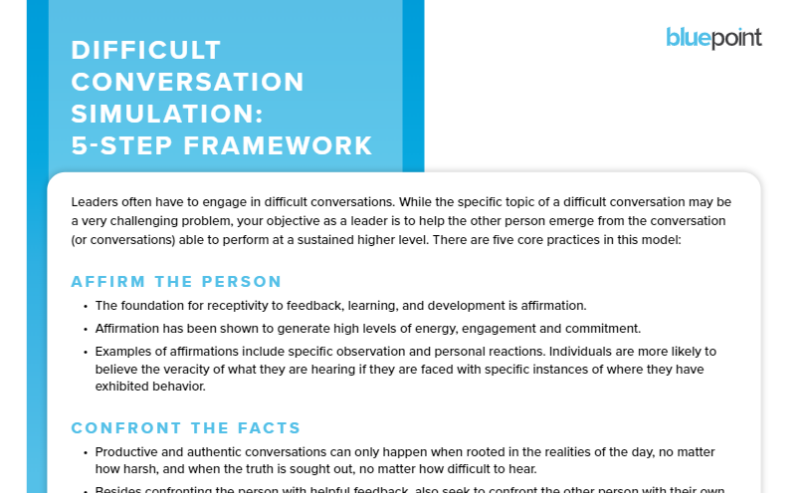There was a time when moving information up and down the organization was one of the biggest parts of a leader’s job. That day has passed. Sure, you still need to make sure that the people in your organization have the accurate and timely information necessary to do their work and your boss needs to know how your business is doing but times have changed. Increasingly, the people in your organization have access to the same information as you, possibly even better access. Information is rapidly and broadly dispersed. Organizations are flattening and losing their boundaries. It’s no longer your job to provide people with high-quality information; it’s your job to get people to think and act differently…and in concert! Unfortunately, many organization leaders continue to function primarily as information brokers. They spend an enormous amount of time and effort gathering information, synthesizing it and providing it to others. People don’t need more information, they need more perspective. They need more meaning. And they need a personal mission. What they really need is more leadership. And the most effective leadership happens one conversation at a time!
It is important to understand that communication is not simply an important leadership competency. It is your leadership. Leadership and communication are synonymous. Virtually everything you do as a leader is a product of your communication. When we think about leadership communication, we usually focus on presentations and formal written material however the real impact comes from the routine conversations we have every day. When asked about a leadership action that dramatically changed their performance or career, the vast majority of people cite a pivotal conversation which changed their view of themselves and their work. Conversations change people and people change organizations. Is this not what leadership is all about?
However, for the leader, being heard, really heard is a daunting task. Most leaders’ voices are simply lost in the din of the meaningless chatter that pervades organizations.
1. The Organization’s Story
Leaders don’t tell stories to be engaging or entertaining. They tell stories because it is the only way others can really hear them. Our brains are hardwired to make sense out of the world by constantly creating and rewriting stories. It’s the leader’s job to remind others of the organization’s story and how their story (the other person’s) connects with and adds to the bigger, organization story. Every conversation presents an opportunity to advance both stories. Are we on a great adventure, out to right a terrible wrong, discover a brave new world or create boundless prosperity for your community? Simply put, great organizations have great stories and great leaders unfold these stories verse by verse, chapter by chapter in every conversation they have. Story injects passion and energy into the work. Story illuminates the path forward. Story brings meaning to the journey. So how do you know if you are having conversations that are advancing the organization’s story? There is only one measure. People are leaving conversations with you with a personal story that is more vivid, more compelling and more alive. People are not simply better informed; they are more aligned, more engaged, more inspired, more committed…and feeling like they have the lead role in the story.
2. The Constructive Confrontation
Organizations that are rife with confusion and ambiguity typically have leaders who avoid confrontations like the plague. These leaders keep themselves distracted with all kinds of busy work rather than engaging in the conversations that may matter most: constructive confrontations.
We all tend to avoid these difficult conversations not because we think these are unimportant but rather because we fear the perceived emotional carnage that will result. The only way to effectively counter this fear is to get clear on our intentions. Why are we having the conversation? The problem with most confrontation situations is that the leader comes bearing negative judgments and an agenda directed at fixing the other person rather than an attitude of service. Constructive confrontation is not about criticizing, blaming or making accusations. Successful leaders confront others not to fix them but out of genuine concern for them and a desire to provide information that will ultimately be valuable to them and help them perform at a higher level. It’s hard to go wrong when your intention is to create a free flowing dialogue unencumbered by defensiveness, negative emotions and competing agendas. When well done, confrontation lowers defenses, creates mutual respect and understanding, increasing commitment and engagement. The key here is your intention. You want something changed, likely the mind or behavior of the other person. Be upfront about that. How do you know if you are having constructive confrontations? First and foremost, you know in your heart-of-hearts that you are all in. You are saying everything that needs to be said and you are walking away from all conversations empty. You don’t leave a story half-told, feedback unspoken or a thorny issue not raised. Secondly, people are routinely thanking you for having the courage to have these conversations based on a remarkably raw level of honesty. They understand how difficult it is to initiate these conversations and they appreciate your commitment to do so.
3. The Coaching Conversation
The coaching conversation is a very special conversation. Unlike every other conversation you have through the course of your day, the coaching conversation is virtually devoid of self-interest. It is all about the other person….and this is not a natural state for most of us. We all want to learn, relate, laugh and be entertained when we speak to others. Nothing wrong with this. It’s normal to have a healthy dose of self interest in our conversations. The hallmark of a coaching conversation is unmistakable: the other person leaves the conversation better in some way. They leave with a new idea, a fresh perspective or a renewed personal commitment. They leave affirmed, challenged or energized. You have helped them see exciting new possibilities, uncover unused talents or approach their work with a whole new attitude. So how does one engage in a coach-like conversation? Two leadership practices are imperative: First, you need to be able to get totally present with the other person, really present. Don’t just seek to learn what’s important to the other person; seek to learn what it is like to be the other person. Think what they think. Feel what they feel. Second, have one overriding question in your mind throughout the entire conversation.
Powerful leadership conversations are the lifeblood of high performing teams and organizations. If your number one job is information broker, watch out. You are about to become extinct. Your new job is to have conversations that help people readily connect with the organization’s story, hear things they will hear from no one else and perform at their very best.
About The Author

Gregg Thompson
Gregg Thompson is a keynote speaker, author and executive leadership coach. As a much-in-demand speaker, Gregg leads his audiences on interactive, highly-engaging learning journeys that are both educational and entertaining. He dares audiences to abandon many of their closest-held beliefs about leadership and to explore new ways of seeing, relating to and influencing others. He confronts audiences with their own biases, judgments and attitudes, and challenges them to replace these with fresh new perspectives and practices. He vividly demonstrates how leaders can make a major shift in their personal impact and use their natural strengths to master the art of leadership. Gregg is the author of The Master Coach written for leaders who understand the impact of coaching on performance and career acceleration. The book is an invitation to leaders who want to make a significant shift in their attitudes, values and behaviors and become more coach-like in all of their daily interactions and conversations.
Related Resources

Beyond the Individual: How Coaching Transforms Teams
leading-teams

7 Leadership Strategies to Combat Change Fatigue
leading-change

Difficult Conversation Simulation: 5-Step Framework
communication
Subscribe to newsletter
Subscribe to our newsletter today and receive innovative, insightful and thought provoking resources (videos, webinars and articles) all effective tools for developing leadership talent.
Connect with Us Today!
This is a gated resource. Contact sales at info@bluepointleadership.com for more information or reach out here: Contact Us
This is a member-only resource. Contact sales at info@bluepointleadership.com for more information.


